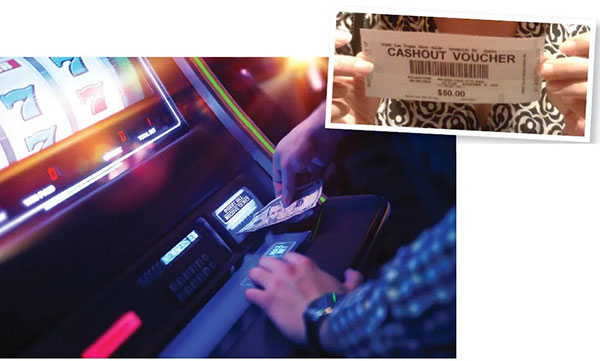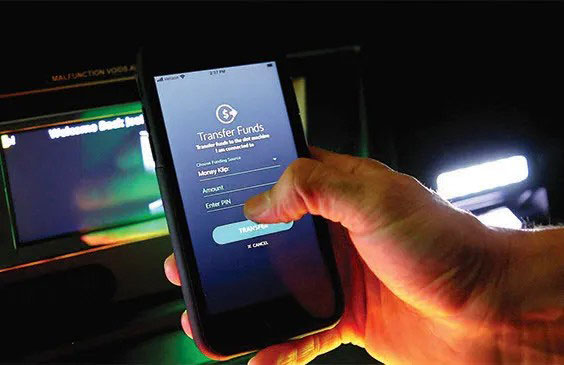TO CASH OR NOT TO CASH?
The technology for cashless slot play is here. Will players use it?
By Frank Legato
 There have been many advancements in technology over the years that have significantly altered the experience of slot play.
There have been many advancements in technology over the years that have significantly altered the experience of slot play.
There was the computerization of the slot machine and subsequent“ virtual reel” technology that allowed jackpot levels to soar. There was the advancement in computer technology that enabled video slot machines to move from Atari-like images of spinning reels to high- resolution video graphics.
There were the changes from the mid-1990s introduction of Aristocrat multi-line games that led to lower denominations—first nickels, and ultimately, pennies. There was the development of advanced math models that led to things like ways-to-win formats and even to formats without spinning reels.
But perhaps more significant than game styles have been the technological changes related to how we pay for our slot sessions. The first change came as a direct result of those lower denominations allowed by multi-line slots. When the first Aristocrat games appeared, the video product on the floor was pretty much limited to video poker. Among slots, mechanical reels dominated the floor, and by and large, the lowest denomination was quarters.
In that atmosphere, it was easy to carry on the tradition of hard coins or metal tokens as the payment method for slot play. Employees with change carts still roamed the floors, and the slots themselves were equipped with coin slots (that’s why they’re called slots), hoppers to hold the coins, and big metal trays that would clang at cash-out, causing the distinctive sound that characterized the slot floors of the day.
Then came those Aristocrat games from Australia in the mid-1990s. Because there were nine, 27 or even (gasp) 45 paylines, each activated by a single coin, nickels were the prominent denomination. There hadn’t been nickel slots, other than a few placed in obscure locations, in decades.
The issue with nickel multi-line games came at cash-out. Routine cash- outs now equaled the number of coins once reserved for big jackpots. The coin hopper wasn’t designed to hold even the thousands of nickels that constituted a cash-out of a few hundred dollars. Invariably, when players cashed out, the hopper would empty, and a wait ensued for a slot attendant, accompanied by security, to bring a sack of nickels over to the machine to complete the player’s winnings—which the player would then lug over to the cage in a big plastic bucket, to convert the coins into folding money.
The nickel multi-line games, though, were wildly popular, particularly after WMS Gaming introduced Reel ’Em In, the first American-made multi-line slot, and the first to offer a funny, animated second-screen bonus, which led to an avalanche of multi-line video slots from the other manufacturers.
Nickels were here to stay, but something had to be done about the coins. The constant cash-out delays and hopper fills were simply unacceptable.

Two separate technological advancements solved the problem. The first was credit play via the bill acceptor. This advancement also had appeared in the 1990s. The multi-line games never would have been tenable without the ability to insert a 20-dollar bill into the machine for 400 nickel credits. But that didn’t solve the cash-out problem.
What would solve it would be the ticket-in/ticket-out, or TITO, system, popularized by IGT’s “EZ Pay” add-on. You place a bill in the acceptor, play the credits, and hit the cash-out button, causing the machine to dispense a ticket that can then either be placed in another machine or taken to the cage or, better yet, a kiosk, which would dispense the folding money.

It was a monumental change that took physical coins out of the slot experience, not to mention leading directly to the still-strong dominance of the penny denomination on the slot floor.
I remember wondering at the time how players would accept such a thing, as pumping coins into a machine and hearing that noise of coins clanging into the hopper tray had been such an essential part of the slot experience.
But in the end, convenience won out. We all accepted the new paradigm — even the cheesy coin-tray sound effects—and TITO is the way most of us still play slots today.
However, the newest movement on the slot technology side, boosted by the COVID-19 pandemic, is cashless slot play—as in no bill acceptors or kiosks required. There are several types of cashless systems being employed today, from systems requiring a deposit account be set up at the cage to systems that can draw directly from bank accounts or credit cards to place credits on your slot meter.
The technology has existed for years. Millions use it to pay for Starbucks, or McDonalds, or to transfer money through Venmo or other apps. It’s how payment has been trending in the wider consumer world. But not in casinos—until now.
Regulatory issues have caused delays here and there in implementing cashless systems in some jurisdictions, and there were fears at first that such ease in funding slot play would cause problem gambling issues as well. However, it has become clear that a completely online or Cloud- based payment system can actually be used to monitor and prevent problem gambling.
That leaves the big question: Will players adopt cashless slot play? My first instinct is to predict a very slow adoption by older players who still make up a huge portion of the slot audience. Younger, “digital-native” players may embrace it, and as the older demographic ages out, cashless play is bound to gain ground. But other players—myself included—are going to stick to the TITO system for now.
Of course, that’s what I first thought about TITO as well, and I was dead wrong. The convenience of not having to deal with coins was a nobrainer. And the systems now being introduced have options where you can still cash out with a ticket, and others that eliminate the player card, and even some with facial recognition.
Some day soon, you may be able to simply sit down at a slot machine, and the machine’s computer will recognize you, begin your pointearning session in the reward club, and ask you how much you want to put on the credit meter.
That’s convenience we may not be able to resist.


